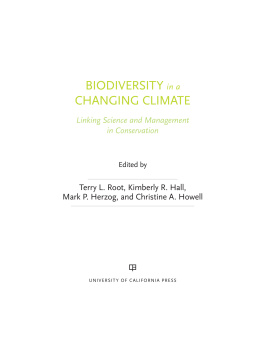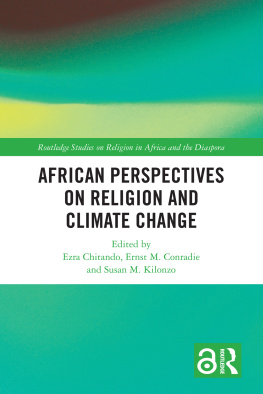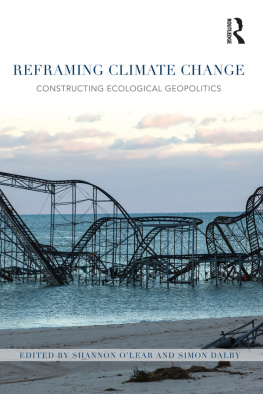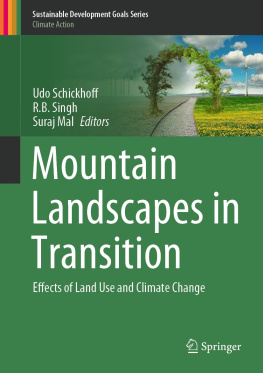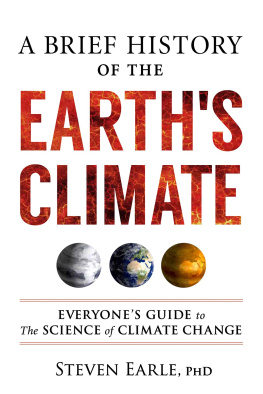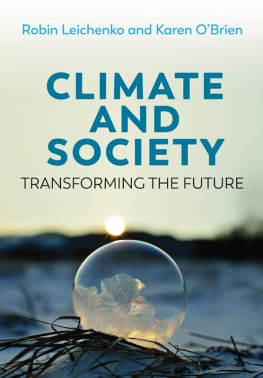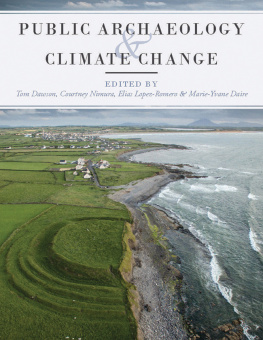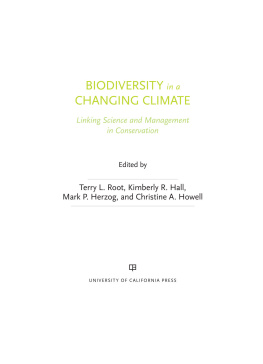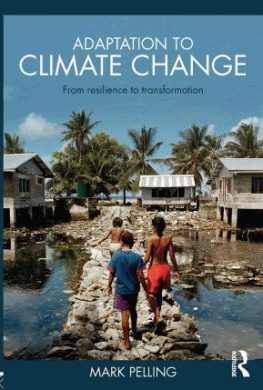BIODIVERSITY in a CHANGING CLIMATE
Linking Science and Management in Conservation
Edited by
Terry L. Root, Kimberly R. Hall, Mark P. Herzog, and Christine A. Howell

UNIVERSITY OF CALIFORNIA PRESS
The publisher gratefully acknowledges the generous contribution to this book provided by the Stephen Bechtel Fund.
University of California Press, one of the most distinguished university presses in the United States, enriches lives around the world by advancing scholarship in the humanities, social sciences, and natural sciences. Its activities are supported by the UC Press Foundation and by philanthropic contributions from individuals and institutions. For more information, visit www.ucpress.edu.
University of California Press
Oakland, California
2015 by The Regents of the University of California
Library of Congress Cataloging-in-Publication Data
Biodiversity in a changing climate: Linking science and management in conservation / edited by Terry L. Root, Kimberly R. Hall, Mark P. Herzog, Christine A. Howell. -- First edition.
p. cm.
Includes bibliographical references and index.
ISBN 978-0-520-27885-1 (cloth : alk. paper) ISBN 0-520-27885-2 (cloth : alk. paper) ISBN 978-0-520-28671-9 (pbk. : alk. paper) ISBN 0-520-28671-5 (pbk. : alk. paper) ISBN 978-0-520-96180-7 (ebook) ISBN 0-520-96180-3 (ebook)
1. BiodiversityClimatic factorsCalifornia. 2. Biodiversity conservationCalifornia. I. Root, Terry Louise, 1954editor. II. Hall, Kimberly Reade, 1967- editor. III. Herzog, Mark Paul, 1969- editor. IV. Howell, Christine Ann, 1969 editor.
QH 105. C 2 B 55 2015
577.2209794--dc232014041571
Manufactured in China
24 23 22 21 20 19 18 17 16 15
10 9 8 7 6 5 4 3 2 1
The paper used in this publication meets the minimum requirements of ANSI / NISO Z 39.48-1992 ( R 2002) ( Permanence of Paper ). 
TO STEPHEN H. SCHNEIDER
A visionary, who not only understood the magnitude of trouble greenhouse gas emissions could cause, but helped us all understand how we must work together to avoid the worst of that trouble. Yet, climate change was not on his list of the worlds five worst problems, which were: Ignorance, Greed, Denial, Tribalism, and Short-Term Thinking. We indeed lost a great man in 2010.
TO GUIDO FRANCO
Without his wisdom, this book and much of Californias problem-solving science related to energy would not occur.
TO PATTY GLICK
An unsung hero in our battle with climate change. She has tirelessly worked to focus the attention of scientist, resource managers, decision makers and the public on the risk of climate change on wildlife.
CONTENTS
Terry L. Root and Kimberly R. Hall
Kimberly R. Hall
Michael D. Mastrandrea and William R. L. Anderegg
William R. L. Anderegg and Terry L. Root
Jeffrey G. Dorman
Christopher J. Osovitz and Gretchen E. Hofmann
Rebecca M. Quiones
Brendan Colloran, Gretchen LeBuhn, and Mark Reynolds
Lori Hargrove and John T. Rotenberry
K. Blake Suttle, Erika S. Zavaleta, and Sasha Gennet
Laura Koteen
Jason P. Sexton and Alden B. Griffith
Jessica L. Blois and Elizabeth A. Hadly
Morgan W. Tingley
LIST OF CONTRIBUTORS
EDITORS
KIMBERLY R. HALL
Michigan State University
MARK P. HERZOG
US Geological Survey
CHRISTINE A. HOWELL
US Forest Service
TERRY L. ROOT
Stanford University
CONTRIBUTING AUTHORS
WILLIAM R. L. ANDEREGG
Princeton University
JESSICA L. BLOIS
University of California, Merced
BRENDAN COLLORAN
Archimedes Incorporated
San Francisco, CA
JEFFREY G. DORMAN
University of California, Berkeley
SASHA GENNET
The Nature Conservancy
San Francisco, CA
ALDEN B. GRIFFITH
Wellesley College
ELIZABETH A. HADLY
Stanford University
LORI HARGROVE
University of California, Riverside
GRETCHEN E. HOFMANN
University of California, Santa Barbara
LAURA KOTEEN
University of California, Berkeley
GRETCHEN LEBUHN
San Francisco State University
MICHAEL D. MASTRANDREA
Stanford University
CHRISTOPHER J. OSOVITZ
University of South Florida
REBECCA M. QUINIES
University of California, Davis
MARK REYNOLDS
The Nature Conservancy
San Francisco, CA
JOHN T. ROTENBERRY
University of California, Riverside
JASON P. SEXTON
University of California, Merced
K. BLAKE SUTTLE
Imperial College London
MORGAN W. TINGLEY
University of Connecticut
ERIKA S. ZAVALETA
University of California, Santa Cruz
MANAGERS
DEBORAH ASELTINE-NEILSON
CA Department of Fish and Wildlife
ANDREA CRAIG
The Nature Conservancy
Los Molinos CA
MARK FISHER
University of California Natural Reserve System
DAN HOWARD
Cordell Bank National Marine Sanctuary
ROB KLINGER
US Geological Survey
Yosemite Field Station
TINA MARK
US Forest Service
Tahoe National Forest
ALLAN MUTH
University of California Natural Reserve System
JULIE PERROCHET
US Forest Service
Klamath National Forest
ANNE POOPATANAPONG
US Forest Service
Idyllwild Ranger Station
JENNY RECHEL
US Forest Service
Pacific Southwest Research Station
MARK STROMBERG
Hastings Natural History Reservation
PREFACE
Terry L. Root and Kimberly R. Hall
Since the mid-1970s, our planet has been experiencing noticeable changes in global climate, such as rapid warming, which have strongly affected humans and natural systems. Current climate projections for the future suggest continued acceleration in the pace of these changes, leading to greater risk of harm, especially for those species and human populations that are least able to cope with change. Until collaborative efforts of governments find ways to reduce substantially the emissions of greenhouse gases and stabilize global climate patterns, those of us interested in conserving biodiversity will need to find direct ways to facilitate species adaptations to ever-changing climate conditions. As scientists and resource managers, it is absolutely essential that we communicate the impacts that we are seeing, as this is one way to help promote climate change mitigation efforts to replace fossil fuel energy with that generated via renewable energy. Further, we must use what we are learning to help develop and implement strategies that prepare people and species for the inevitable continued changes in climate that will occur before mitigation strategies can produce results. Indeed, if we fail to act in these ways, the number of species extinctions will likely be higher than humanity can afford to lose.
The challenge of helping natural systems adapt is huge, but not insurmountable, if all concerned pool their knowledge, expertise, and resources. Specifically, we are referring to scientists conducting decision-relevant research, natural resource managers, and conservation practitioners implementing climate-updated protocols in the field, and, especially, decision-makers who help shape policy. Strengthening the dialogue between researchers and practitioners will inevitably inspire new, proactive approaches to management. This kind of partnership also provides opportunities to identify constraints to the kinds of innovative actions needed to reduce risks to natural (and human) systems, as some actions may require changes in existing policies or new legislative tools before they can be implemented. By strengthening scientistmanager partnerships and aligning our messaging, we also improve our ability to promote needed updates to those in a position to implement policy change. As we strengthen these relationships, we also increase the odds that we will save a greater number of species from extinction, and will protect more people from climate-related risks.

